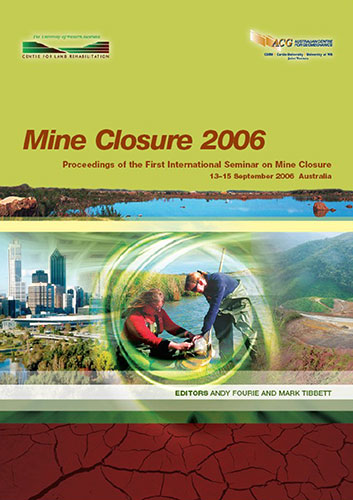Incorporation of Terrestrial Invertebrate Data in Mine Closure Completion Criteria Adds Sensitivity and Value

|
Authors: Majer, JD; Orabi, G; Bisevac, L |
DOI https://doi.org/10.36487/ACG_repo/605_62
Cite As:
Majer, JD, Orabi, G & Bisevac, L 2006, 'Incorporation of Terrestrial Invertebrate Data in Mine Closure Completion Criteria Adds Sensitivity and Value', in AB Fourie & M Tibbett (eds), Mine Closure 2006: Proceedings of the First International Seminar on Mine Closure, Australian Centre for Geomechanics, Perth, pp. 709-717, https://doi.org/10.36487/ACG_repo/605_62
Abstract:
Inspection of the few documented criteria for evaluating whether rehabilitated minesites have reached a stage where bond-release can occur, or where responsibility for the land can be relinquished, reveals a largely generic approach. Criteria include site safety, soil stability, and aesthetic issues. The biological criteria tend to be extremely generic in their approach, and include plant cover, plant density, plus a range of surrogate indicators of animal habitat, such as the existence of coarse woody debris. Although a range of habitat factors may be present, there are often no data to indicate whether the previous occupants have returned, or whether the ecosystem is functioning in a self-sustaining way. When fauna are included, the focus is generally on the vertebrates, as these are the groups that engender public interest and concern. Invertebrates tend to be omitted from the agenda, even though they play a vital role in ecosystem functioning. This paper presents a case for including invertebrates in the list of mine closure Completion Criteria. It does so on the premise that invertebrates comprise the bulk of animal biomass and most of its biodiversity, and also because of their role in processes such as pedogenesis, nutrient cycling, pollination, etc. Two studies which ‘road- test’ the efficacy and cost-effectiveness of various invertebrate groups as indicators of rehabilitation success are presented, one on the Iluka sand mines at Eneabba, WA, and the other on the Worsley Alumina bauxite mines, near Boddington, WA. In both cases, groups such as ants, beetles, spiders and hemipterans provide insightful data on the way in which the ecosystem is recovering. The degree to which these groups track ecosystem recovery often exceeds that of the vertebrates. Furthermore, the cost of surveying certain groups of invertebrates is far more economical in terms of expense and data-yield than that which is involved in surveying vertebrates. The former does require specialised expertise and equipment. However, such expertise is now becoming available in the consulting industry and the necessary equipment is inexpensive, so this should not be seen as an impediment. In view of the resources required to carry out this work, and also of the need to provide rapid assessments of closure success in various minesites, it is recommended that invertebrates be used in a subset of the mined areas, using representative areas of mature rehabilitation.
References:
Abbott, I. (1989) The influence of fauna on soil structure. In Animals in Primary Succession: The Role of Fauna in
Reclaimed Lands. Ed. J. D. Majer. Cambridge University Press, Cambridge, pp. 39-50.
Belbin, L. (1980) TWOSTEP: a program incorporating asymmetric comparisons that uses two steps to produce a
dissimilarity matrix. CSIRO Division of Land Use Research Technical Memorandum 80/9. CSIRO, Canberra.
Belbin, L. (1995) PATN Technical Reference. CSIRO Division of Wildlife and Ecology, Canberra.
Czekanowski, J. (1932) Coefficient of racial likeness, und durchschnittliche differenz. Anthropologischer Anzeiger 9:
227-249.
EPA (2006) Guidance for the Assessment of Environmental Factors. Draft Guidance Statement No. 6. Rehabilitation of
Terrestrial Ecosystems. Environmental Protection Authority of Western Australia, Perth.
Erwin, T.L. (1991) How many species are there? Revisited. Conservation Biology 5, pp. 330-333.
Faegri, K. and van der Pijl, L. (1971) The Principles of Pollination Ecology. Pergamon Press, London.
Hutson, B.R. (1989) The role of fauna in nutrient turnover. In Animals in Primary Succession: The Role of Fauna in
Reclaimed Lands. Ed. J. D. Majer. Cambridge University Press, Cambridge, pp. 51-70.
Majer, J.D. (1989) Fauna studies and land reclamation technology - a review of the history and need for such studies. In
Animals in Primary Succession: The Role of Fauna in Reclaimed Lands. Ed. J. D. Majer. Cambridge University
Press, Cambridge, pp. 5-33.
Majer, J.D. (1990) Rehabilitation of disturbed land: Long term prospects for the recolonization of fauna. Proceedings of
the Ecological Society of Australia 16, pp. 509-519.
McKenzie, N.L., Keighery, GJ., Gibson, N. and Rolfe, J.K. (2000) Patterns in the biodiversity of terrestrial
environments in the southern Carnarvon Basin, Western Australia. Records of t the Western Australian Museum
Supplement No. 61, pp. 511-546.
Mills, C., Chandler, R. and Caporn, N. (1992) Completion Criteria. Proceedings of Conference on Management and
Rehabilitation of Mined Lands. Curtin University of Technology, Perth.
Tacey, W. and Treloar, J. (1994) What do we want Completion Criteria to achieve? Proceedings of the 19th Australian
Mining Industry Council Environmental Workshop. AMIC, Canberra, pp. 246-256.
Waggitt, O.W. and McQuade, C.V. (1994) Mine close-out Criteria - Present guidelines and future trends in Australia.
Proceedings of the AusIMM Annual Conference, Darwin, pp. 407-410.
Ward, S.C., Majer, J.D. and O’Connell, A.M. (1991) Decomposition of eucalypt litter on rehabilitated bauxite mines.
Australian Journal of Ecology 6, pp. 251-257.
Whelan, R.J. and Main, A.R. (1979) Insect grazing and post-fire succession in south-west Australian woodland.
Australian Journal of Ecology 4, pp. 387-398.
Wilson, E.O. (1987) The little things that run the world (the importance and conservation of invertebrates).
Conservation Biology 1, pp. 344-346.
Success Criteria
Mine Closure 2006, Perth, Australia 717
© Copyright 2025, Australian Centre for Geomechanics (ACG), The University of Western Australia. All rights reserved.
View copyright/legal information
Please direct any queries or error reports to repository-acg@uwa.edu.au
View copyright/legal information
Please direct any queries or error reports to repository-acg@uwa.edu.au